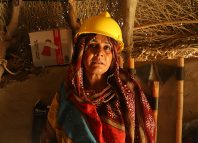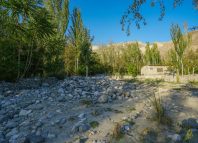Sikander’s Story of Resilience: When the Waters Came, They Stood Together
Sikander, a farmer from Babu Syal in Umerkot, is regarded as a pillar of strength by his community; a place where the climate swings from relentless heat that scorches the earth to sudden, destructive monsoon floods. For the sharecropping families of this region, the land is more than just livelihood; it is legacy, sustenance, and survival. Protecting it is not a choice, but a necessity. Sikander understood this deeply, and when he recognised a recurring threat that others hesitated to confront, he chose action over silence.
Living with his mother, wife, children, and siblings, Sikander has long relied on farming to support his family. In 2011, torrential floods swept through Umerkot, leaving behind a trail of devastation. Homes were destroyed, fields submerged, and entire villages lost beneath rising waters. With no preparedness measures in place, communities were left vulnerable and exposed.




The floods of 2022 brought renewed crisis, this time on a national scale. Sikander’s village remained submerged for nearly three months, while surrounding farmlands stayed underwater even longer. The repeated trauma of these disasters galvanised the community. No longer willing to remain unprepared, they committed to building resilience and safeguarding their future.
Through the support of Community World Service Asia’s disaster resilience initiatives, Sikander and his fellow villagers are now charting a new path; one rooted in preparedness, collective strength, and hope. In 2023, Community World Service Asia (CWSA) identified flood-prone regions of Umerkot and introduced disaster preparedness and climate change adaptation trainings. Sikander was among the participants and later joined the Disaster Risk Reduction Committee set up under CWSA’s initiatives supported by CWS Japan and Ministry of Foreign Affairs (MOFA) Japan.
By the time the monsoon rains returned in 2024, Sikander, equipped with disaster preparedness training, emerged as a unifying force, rallying not only his own village but neighboring communities as well. For twenty consecutive days, they stood as the frontline against impending disaster, working tirelessly to safeguard their lands and livelihoods.




Under Sikander’s leadership, villagers mobilised every available resource; tractors, fuel, manpower, and even dipped into their own savings to sustain the effort. Men laboured without pause, clearing blocked canals and reinforcing embankments to redirect floodwaters. It was a remarkable display of collective resilience, where women played a vital role by preparing and delivering hot, home-cooked meals and fresh rotis to those working in the field from dawn to dusk.
True to the wisdom that prevention is better than cure, the community acted swiftly on early flood alerts, implementing proactive measures before the crisis could escalate. Their efforts paid off: thousands of acres of farmland and hundreds of homes were protected from destruction. Through the construction of barrier walls, strategic placement of sandbags, and careful management of drainage systems, they successfully averted catastrophic flooding.
Sikander also coordinated with the Livestock Department to ensure timely vaccinations, safeguarding animals from seasonal disease and further loss. His leadership reflects the power of community-led action, where preparedness, solidarity, and timely intervention can transform vulnerability into resilience.


When asked why they worked collectively instead of individually, the answer was simple, “Who could have achieved this alone? Why wouldn’t a person go to every length to save his home, his land, his life’s work? Every village was at risk. Every man had to take charge.” Sikander had long believed that the community’s unity would be their greatest defense against calamity. Even when others were hesitant at first, he persistently urged them to prepare for what lay ahead.
Sikander’s unwavering determination earned him the gratitude of his people. He recalls, “They spoke my name in their prayers and showered me with good wishes.”
Today, after participating in these training sessions, Sikander trusts his instincts and uses his courage to turn resilience into action. “We will not only use these techniques to reduce flood risks ourselves,” he says, “but also pass them down to our children. We cannot change the entire village system overnight, but step by step we are moving toward resilience.”







